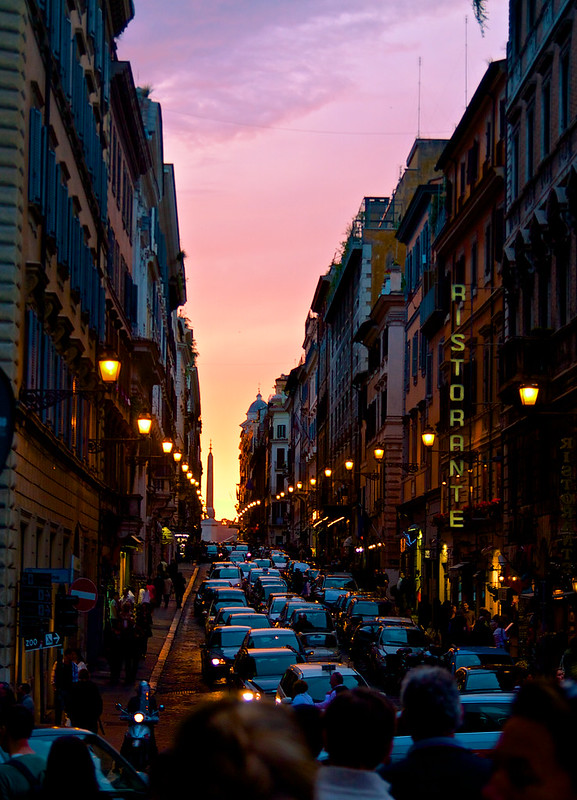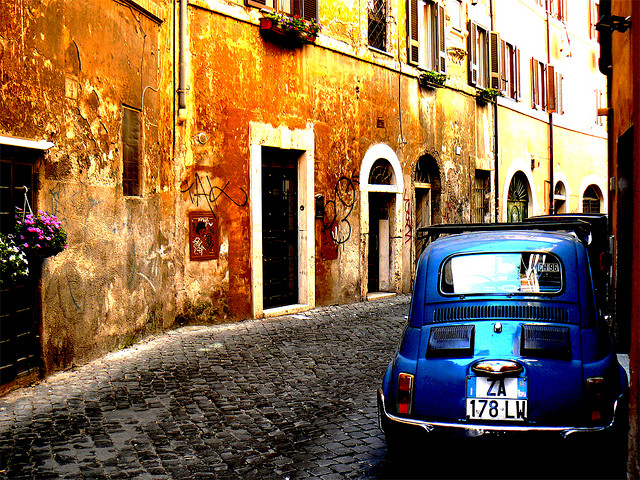Some cities were built all at one time, in one piece; they’re single visions, like St. Petersburg with its concentric canals and classical buildings, or Bath with its fashionable crescents and squares. But Rome has layer upon layer of history, of archaeology.
Vagabondish is reader-supported. When you buy through links on our site, we may earn a small affiliate commission. Read our disclosure.
You have to unpeel (and keep unpeeling) Rome, like an onion, from Mussolini’s Rome, through Verdi’s and King Vittorio Emanuele’s Rome, back to baroque Rome, Renaissance Rome, the medieval Rome of Popes and consuls, the Roman Empire, the Republic and all the way back to the first prehistoric dwellings on top of the Capitoline hill.
Rome is “deep” in every way. You appreciate this when you come to San Clemente, a church already half buried beneath road level. Beneath the church is a second, older church. And beneath that are the remains of a Roman Mithraeum, where a Persian god was worshiped with the sacrifice of a bull, and devotees were baptised in the bull’s blood.
Elsewhere the Capitoline Museum showcases the foundations of the great temple of Jupiter, beneath Michelangelo’s reworking of the Capitoline palaces (behind his fine façades you can still see the medieval arcades on the inside — another example of the multiple onion peels). In San Giovanni e Paolo on the Celian hill, the church is built on top of Roman houses which can be visited; nearby San Gregorio Magno still occupies the site of Pope Gregory the Great’s family villa, on which he had already built a small oratory before he was elected pope. Though the Roman ruins in its grounds might just be ancient tabernae, some people think they are the ruins of the oratory.
Rome reuses its past. Michelangelo built Santa Maria degli Angeli out of parts of Diocletian’s baths; poke around a bit and you can still see the fabric of the baths under the mannerist design. Renaissance popes reconstructed classical aqueducts and added fine fountains; Hadrian’s tomb, famously, became a fortress, Castel Sant’Angelo; and one of my favourite sights, the ‘Casa di Crescenzio’ near the Ponte Palatino, reuses architectural fragments from classical buildings in an early medieval house. Maybe the master of the house wanted to claim himself as a successor to the Senate and the Empire, or maybe he’d just found reused fragments cheaper than newly dressed stone; whatever his motive, he created something quite unusual but quite in keeping with Rome’s history and traditions.
Medieval houses occupy corners of classical buildings — the arcades of the Theatre of Marcellus blocked up to make windows for tenements, medieval towers in the ruins of the Forum of Trajan. San Nicola in Carcere is perhaps the most extravagant reuse, occupying the ruins of no fewer than three ancient temples — you can see the portico of one fossilised within the side wall of the church.
Santa Maria in Cosmedin is one of Rome’s loveliest churches but also one of its most patchwork buildings. Look closely at the inside of the façade and you can see where the Statio Aquarum depot from which food was distributed has been incorporated into the building. Architectural reuse echoes the reuse of Roman institutions; the Catholic Church took over from the Roman state as provider of charity (just as the Pope took over the Roman emperor’s title of Pontifex Maximus).

Sunset on the Streets of Rome © Zach Dischner
As for the ‘Bocca della Verita’, the ‘mouth of truth’ under the arcade at the front of the church, it’s actually an ancient Roman manhole cover.
On the Tiber Island, the ancient temple of the healing god Aesculapius continued its good work as a hospital under the dedication of St Bartholomew; unusually, the church contains a well — the spring of Aesculapius. Again, Rome reuses its past (Tiber island is one of my favourite places to hang out in Rome; there’s a good ice cream parlour on the little square and it never seems to be too busy).
St John Lateran is an interesting example of reuse. It looks today like a baroque church thanks to a remodelling by Borromini; but behind the dramatic rhythm of the pillars and niches you can just, if you look very hard, detect the even rhythm of the Romanesque arcade.
All these layers, all these re-uses, create a sense of the city in which the past is ever-present, in which you are living in and seeing several centuries, even several millennia all at the same time. What’s ‘original’ and what’s not isn’t a question you can answer here; everything flows and fuses — temples and churches, emperors and popes and even the ridiculous ‘wedding cake’ become part of a triumphant and eternal whole.
The Italian Talks blog offers Italy travel tips written by Italian journalists and bloggers.



